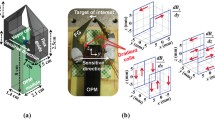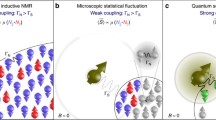Abstract
Direct detection of neural activity with MRI would be a breakthrough innovation in brain imaging. A Lorentz force method has been proposed to image nerve activity using MRI; a force between the action currents and the static MRI magnetic field causes the nerve to move. In the presence of a magnetic field gradient, this will cause the spins to precess at a different frequency, affecting the MRI signal. Previous mathematical modeling suggests that this effect is too small to explain the experimental data, but that model was limited because the action currents were assumed to be independent of position along the nerve and because the magnetic field was assumed to be perpendicular to the nerve. In this paper, we calculate the nerve displacement analytically without these two assumptions. Using realistic parameter values, the nerve motion is <5 nm, which induced a phase shift in the MRI signal of <0.02°. Therefore, our results suggest that Lorentz force imaging is beyond the capabilities of current technology.



Similar content being viewed by others
References
Bandettini PA, Petridou N, Bodurka J (2005) Direct detection of neuronal activity with MRI: fantasy, possibility, or reality? Appl Magn Reson 29:65–88
Clark J, Plonsey R (1968) The extracellular potential field of the single active nerve fiber in a volume conductor. Biophys J 8:865–875
Feychting M (2005) Health effects of static magnetic fields: a review of the epidemiological evidence. Prog Biophys Mol Biol 87:241–246
Hammer HB, Hovden IAH, Haavardsholm EA, Kvien TK (2006) Ultrasonography shows increased cross-sectional area of the median nerve in patients with arthritis and carpal tunnel syndrome. Rheumatology 45:584–588
Jackson JD (1999) Classical electrodynamics, 3rd edn. Wiley, New York
Koretsky AP (2012) Is there a path beyond BOLD? Molecular imaging of brain function. Neuroimage 62:1208–1215
Love AEH (1944) A treatise on the mathematical theory of elasticity. Dover, New York
Ohayon J, Chadwick RS (1988) Effects of collagen microstructure on the mechanics of the left ventricle. Biophys J 54:1077–1088
Poplawsky AJ, Dingledine R, Hu XPP (2012) Direct detection of a single evoked action potential with MRS in Lumbricus terrestris. NMR Biomed 25:123–130
Rodionov R, Siniatchkin M, Michel CM, Liston AD, Thornton R, Guye M, Carmichael DW, Lemieux L (2010) Looking for neuronal currents using MRI: an EEG-fMRI investigation of fast MR signal changes time-locked to frequent focal epileptic discharges. NeuroImage 50:1109–1117
Roth BJ (2011) The role of magnetic forces in biology and medicine. Exp Biol Med 236:132–137
Roth BJ, Basser PJ (2009) Mechanical model of neural tissue displacement during Lorentz effect imaging. Magn Reson Med 61:59–64
Song AW, Takahashi AM (2001) Lorentz effect imaging. Magn Reson Imag 19:763–767
Truong T-K, Wilbur JL, Song AW (2006) Synchronized detection of minute electrical currents with MRI using Lorentz effect imaging. J Magn Reson 179:85–91
Sundaram P, Wells WM, Mulkern RV, Bubrick EJ, Bromfield EB, Munch M, Orbach DB (2010) Fast human brain magnetic resonance responses associated with epileptiform spikes. Magn Reson Med 64:1728–1738
Truong T-K, Song AW (2006) Finding neuroelectric activity under magnetic-field oscillations (NAMO) with magnetic resonance imaging in vivo. Proc Natl Acad Sci 103:12598–12601
Xue YQ, Chen XY, Grabowski T, Xiong JH (2009) Direct MRI mapping of neuronal activity evoked by electrical stimulation of the median nerve at the right wrist. Magn Reson Med 61:1073–1082
Wijesinghe RS, Roth BJ (2009) Detection of peripheral nerve and skeletal muscle action currents using magnetic resonant imaging. Ann Biomed Eng 37:2402–2406
Woosley JK, Roth BJ, Wikswo JP Jr (1985) The magnetic field of a single axon: a volume conductor model. Math Biosci 76:1–36
Acknowledgments
This research was supported by the National Institutes of Health grant R01EB008421.
Author information
Authors and Affiliations
Corresponding author
Appendix
Appendix
1.1 Potential and current density along an axon
The calculation of potential and current density is identical to that presented previously [2, 19]. The transmembrane potential V m(z) varies along the axon and can be expressed in terms of its Fourier transform V m(k)
where
and k is the spatial frequency. The intracellular potential, V i(r,z), and extracellular potential, V e(r,z), obey Laplace’s equation. At the membrane, the difference between V i(a,z) and V e(a,z) is equal to the transmembrane potential, and the membrane current is continuous. Clark and Plonsey [2] showed that the Fourier transforms of the potentials are therefore
and
where
and I 0, I 1, K 0, and K 1 are modified Bessel functions [5]. The intracellular (r < a) and extracellular (r > a) current densities in the r and z directions are
1.2 Magnetic field perpendicular to the axon
Assume that a magnetic field of strength B 0 points in the x direction, perpendicular to the axon (Fig. 1)
The Fourier transform of the Lorentz force per unit volume, \({\mathbf{F}} = {\mathbf{J}} \times {\mathbf{B}}\), is
In our mechanical model, the tissue experiences pressure and undergoes displacements. The stress tensor, τ ij , is [8]
where p is the hydrostatic fluid pressure, ε ij is the strain tensor, μ is the tissue shear modulus, and T ij is the Maxwell stress tensor [5] that results in the Lorentz force. We assume that the shear modulus is the same within the nerve and in the surrounding tissue.
The stress tensor specifies the stress in the tissue, but to determine the net force on an element of tissue, we must examine how the stress changes with position. For instance, if the stress is larger on the left side of an element of tissue than on the right that tissue element will experience a net force. Mathematically, the divergence of the stress tensor gives Navier’s equation that describes the elastic state of the medium in static equilibrium and says that the sum of the forces (elastic plus magnetic) is zero. Navier’s equation in polar coordinates is [7]
In the linear approximation, the displacement of the tissue, u = (u r , u θ , u z ), is related to the strain tensor by [7]
We assume that the tissue is incompressible (∇ · u = 0), which implies that the displacement can be specified by a stream function ψ, a scalar function whose spatial derivatives give the components of the displacement vector [7]
These relationships allow the solution of Navier’s equation to be stated in terms of two scalar functions: the pressure and the stream function. At the boundary of the nerve (r = a), the displacement and radial components of the stress tensor are continuous.
We have found an analytical solution to Navier’s equation subject to these boundary conditions. Inside (i) and outside (e) of the nerve, the Fourier transform of the stream function and pressure are given by
These expressions are complicated, but become simpler if |k|a ≪ 1, which means that the spatial extent of the action potential (and more specifically, of the rising phase of the action potential) is much greater than the radius. The intracellular stream function then becomes
This stream function is consistent with a displacement in the y direction of
In the limit of |k|a ≪ 1, the current density in Eq. (8) becomes J iz = ikσ i V m, so the displacement is
1.3 Magnetic field parallel to the axon
Now assume that the magnetic field points in the z direction, parallel to the axon (Fig. 2)
In this case, the Fourier transform of the Lorentz force is
The force is entirely in the θ direction, is independent of θ, and causes a twisting motion about the axis of the axon.
Using the same mechanical model as described earlier, the pressure is zero and the Fourier transform of the stream function is given by
1.4 Numerical methods
To perform the numerical calculations, we performed the Fourier transforms and Bessel function calculations in MATLAB. We approximated the z axis with a grid of 121 points, using a distance between points of 0.2 mm. For the transmembrane potential, we used the three-Gaussian approximation to the action potential used by Clark and Plonsey [2].
Rights and permissions
About this article
Cite this article
Roth, B.J., Luterek, A. & Puwal, S. The movement of a nerve in a magnetic field: application to MRI Lorentz effect imaging. Med Biol Eng Comput 52, 491–498 (2014). https://doi.org/10.1007/s11517-014-1153-y
Received:
Accepted:
Published:
Issue Date:
DOI: https://doi.org/10.1007/s11517-014-1153-y




